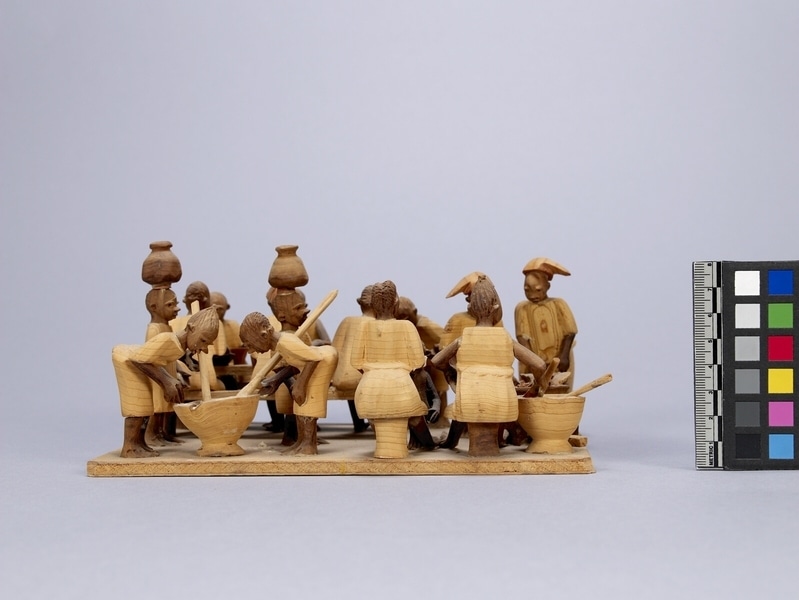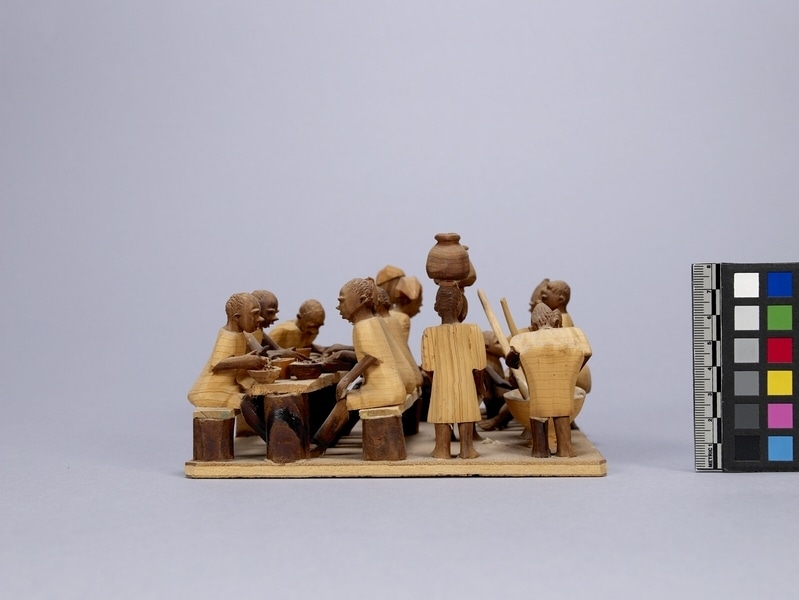Thorn Carving Item Number: Af359 from the MOA: University of British Columbia





Description
Domestic scene including fifteen people, six of which are at a table, two are bearing pots on their heads, two are stirring food in a pot, one is tending a child, one is ladling food from a pot, and two are watching a cooking pot. There is a large empty pot in one corner. The figures at the table and two standing over a cooking pot are wearing shorts, one wearing a sleeveless shirt while the others are wearing short-sleeved shirts. One at the table is wearing a round hat while two at the cooking pot are wearing soft conical hats. All other figures, except the naked child, are wearing knee-length dresses. Two serving pots contain a hardened glue-like substance while the cooking pot and bowls on the table contain shavings. There is a large spoon in the cooking pot and a stirring stick in one serving pot. The cooking pot has a tripod support and two sticks under it. Table, benches, three serving pots, stirring sticks, and clothing other than hats are light yellow-brown. Human bodies, pots on heads, cooking pot, and seven bowls are dark brown. Hats, contents of cooking pots, small bowls, and cups are light red. Base is brown plywood.
History Of Use
Thorn carvings are miniatures depicting scenes from Nigerian life. This type of carving began circa 1930. Thorns vary in size. They can be as large as 12.7 cm. long and 9.6 cm. wide. They are comparatively soft and easily carved. The light yellow-brown thorn and the dark brown thorn come from the Ata tree; the light red-brown thorn comes from Egun trees. The parts are glued together with viscous paste made from rice cooked with water. They are carved by men.
Cultural Context
craft; tourist art
Iconographic Meaning
Verandah cooking scene; a fireplace and utensils used for preparing food are kept there; food would be prepared and eaten there by the family.
Item History
- Made in Nigeria before 1972
- Collected during 1972
- Owned by Andrew Stewart and Jessie Stewart before February 8, 1980
- Received from Andrew Stewart (Donor) and Jessie Stewart (Donor) on February 8, 1980
What
- Name
- Thorn Carving
- Identification Number
- Af359
- Type of Item
- carving
- Material
- atum thorn, egun thorn, wood and rice adhesive
- Manufacturing Technique
- carved and glued
- Overall
- height 9.5 cm, width 21.8 cm, depth 17.0 cm
Who
- Culture
- Yoruba
- Previous Owner
- Andrew Stewart and Jessie Stewart
- Received from
- Andrew Stewart (Donor) and Jessie Stewart (Donor)
Where
- Holding Institution
- MOA: University of British Columbia
- Made in
- Nigeria
When
- Creation Date
- before 1972
- Collection Date
- during 1972
- Ownership Date
- before February 8, 1980
- Acquisition Date
- on February 8, 1980
Other
- Item Classes
- carvings & sculpture
- Condition
- fair
- Accession Number
- 0590/0045